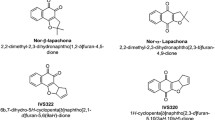Abstract
Protoanemonin, a component of Ranunculus bulbosus, was tested as an antifungal agent on selected strains of dermatophytes and yeasts. The minimum inhibitory concentrations ranged from 2.0 to 7.5×10−4 M and the minimum lethal concentrations from 3.8×10−4 M to >1.0×10−3 M. The most sensitive dermatophyte tested was Epidermophyton floccosum, and the most sensitive yeast Rhodotorula glutinis. The effects of different culture media and of light on the sensitivity of Rhodotorula glutinis to protoanemonin were also tested. Structural analogies between protoanemonin and other cytotoxic unsaturated lactones, and the reversal by the amino acid cysteine of the antifungal action suggest a possible mechanism of action.
Similar content being viewed by others
References
Asahina Y, Fujita A: Synthesis and constitution of anemonin. J Pharm Soc Japan 455:1–4, 1920.
Bonora A, Mares D: A simple colorimetric method for detecting cell viability in cultures of eukariotic microorganisms. Curr Microbiol 7:217–222, 1982.
Bonora A, Bruni A: Presenza di protoanemonina nelle Ranunculaceas quale parametro chemiotassonomico. Atti del Convegno:Prospettive di ricerca interdisciplinare nel mondo vegetable. Siena 13–15 Maggio p. 28, 1983.
Caltrider PG: Protoanemonin. In: JW Corcoran, F Hahn (eds) Antibiotics. Mechanism of action. Springer-Verlag, Berlin-Heidelberg & New York, Vol. I, 1967, pp 671–673.
Calzada J, Ciccio JF, Echandi G: Antimicrobial activity of the heliangolide chromolaenide and related sequiterpene lactones. Phytochemistry 19:967–968, 1980.
Carns HR, Addicott FT: The effect of herbicides on endogenous regulator systems. In: LJ Audus (ed). The physiology and biochemistry of herbicides. Academic Press, London, New York, 1964, pp 341–356.
Cavallito CJ, Haskell TH: The mechanism of action of antibiotics. The reaction of unsaturated lactones with cysteine and related compounds. J Am Chem Soc 67:1991–1994, 1945.
Dal Pozzo A, Dansi A, Biassoni M: α., β -Unsaturated γ-lactones correlations between lipophilicity and biological activity. Arzneim-Forsch/Drug Res 29:877–882, 1979.
Hall IH, Lee KH, Mar EC, Starnes CO, Waddell TG: Antitumoral agents. 21. A proposed mechanism for inhibition of cancer growth by tenulin and helenalin and related cyclopentenones. J Med Chem 20:333–336, 1977.
Hall IH, Lee KH, Starnes CO, Muraoka O, Sumida Y, Waddell TG: Antihiperlipidemic activity of sesquiterpene lactones and related compounds. J Pharm Sci 69:694–696, 1980.
Holden M, Seegal BC, Baer H: The range of antibiotic activity of protoanemonin. Proc Soc Exp Biol Med 66:54–60, 1947.
Kupchan SM, Eakin MA, Thomas AM: Tumor inhibitors. 69. Structure-cytotoxicity relationships among the sesquiterpene lactones. J Med Chem 14:1147–1152, 1971.
Marchant R, Smith DG: Wall structure and bud formation in Rhodotorula glutinis. Arch Mikrobiol 58:248–256, 1967.
Mares D, Vannini GL, Fasulo MP, Bruni A: Submicroscopic morphology of Trichophyton mentagrophytes grown at different temperatures. Mycopathol 61:43–48, 1977.
Misra SB, Dixit SN: Antifungal principle of Ranunculus sceleratus. Econ Bot 34:362–367, 1980.
Naef-Roth S: Production and bioassay of phytotoxins. In: RKS Wood, A Ballio, A Graniti (eds) Phytotoxins in plant diseases. Academic Press, London, New York, 1972, pp 49–69.
Paris RR, Moyse H: Précis de matière médicale. Masson (Ed). Paris, Vol. II, 1981, pp 151–153.
Ryley JF, Wilson RG, Gravestock MB, Poyser JP: Experimental approaches to antifungal chemotherapy. In: S Garattini, A Goldin, F Hawking, IJ Kopin, RJ Schnitzer (eds) Advances in pharmacology and chemotherapy. Academic Press, New York, Vol. 18, 1981, pp 49–176.
Thimann KV, Bonner WD: Inhibition of plant growth by Protoanemonin and Coumarin, and its prevention by BAL. Proc Natl Acad Sci US 35:272–276, 1949.
Tocan V, Baron O: Sull' attività antibiotica della protoanemonia isolata dal Ranunculus oxyspermus M. B. Boll Chim Farm 108:789–791, 1969.
Veldstra H, Havinga E: On the physiological activity of unsaturated lactones. Enzymologia 11:373–380, 1945.
Woodward JR, Cirillo VP, Edmunds LN: Light effects in yeast: Inhibition by visible light of growth and transport in Saccharomyces cerevisiae grown at low temperatures J Bacteriol 133:692–698, 1978.
Author information
Authors and Affiliations
Rights and permissions
About this article
Cite this article
Mares, D. Antimicrobial activity of protoanemonin, a lactone from ranunculaceous plants. Mycopathologia 98, 133–140 (1987). https://doi.org/10.1007/BF00437648
Issue Date:
DOI: https://doi.org/10.1007/BF00437648




